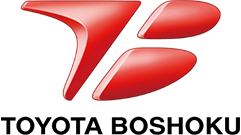Products created through a meeting of many minds
The thinking behind MONOZUKURI
There are always many people involved in our MONOZUKURI (manufacturing and craftsmanship) process. Let’s take the example of Toyota’s MIRAI fuel cell vehicle, which was launched in December 2020 following a complete redesign. This car uses many parts developed by us, which are unique to fuel cell vehicles. Below, we introduce the thoughts of the developers behind the development of these components found in the MIRAI.
Do you know how a fuel cell vehicle generates energy? Fuel cells require hydrogen and oxygen in order to generate electricity. Hydrogen must be replenished at hydrogen stations, and oxygen must be taken in from the air. However, there are many harmful substances in the air, so we cannot use it in its unaltered state. This is where the air cleaner comes into play.
In developing the air cleaner, we focused on improving the precision of the installed filter. By adding an electrostatic function to the conventional particulate removal filter, it removes the fine particles known as PM2.5 at a high rate. Furthermore, the incorporation of an adsorbent-coated chemical filter provides highly efficient removal of SO2, NO2, and NH3, the three main precursor gases responsible in generating PM 2.5 pollution, thereby reducing the occurrence of PM2.5. When using a new adsorbent, concerns must be thoroughly identified as to how this will affect the other materials. Therefore, from the development stage, customers, suppliers, material experts, and quality personnel gathered to exchange views. Visits were also made several times to the plant to make repeated improvements. Eventually, we succeeded in developing a PM2.5 high-efficiency removal air cleaner filter that eliminated all such concerns and achieved world-leading high-efficiency removal without compromising conventional airflow performance. Our product also helps to realize Toyota’s new concept of “Minus Emissions,” in which the more you drive, the cleaner the air becomes.


High productivity achieved by confronting the challenges posed by each product
A fuel cell vehicle is powered by electricity generated through the reaction of hydrogen and oxygen. Its power generation system is equipped with as many as 330 separators, which are titanium plate components. The surface of the separator is formed with fine grooves called channels, through which oxygen, hydrogen, and cooling water pass. In fact, it is very difficult to make fine grooves in a thin plate, and the development of the fuel cell stack separator for the MIRAI was quite a challenge, as we were aiming for even faster production in order to contribute to the spread of carbon-neutral fuel cell vehicles, while maintaining the high precision and visual quality of conventional products.
High-speed production requires advanced technology that allows us to stably produce separators formed with fine channels where the hydrogen and oxygen react more easily, while mastering the characteristics of the materials. We developed a new stamping method for separators by applying our proprietary high-precision, high-speed stamping and die technologies used in the reclining mechanism of automobile seats. This enabled us to create complex and dense channels using a thinner plate than before. We worked together with customers from the material development process, and related departments also collaborated from the prototype stage in the production process. As a result, we succeeded in significantly shortening the channel-forming process, enabling high-speed production.


Someone’s thinking has gone into every single part
Both the parts that you can actually see and the interior are brimming with our thinking and ideas. For example, the vehicle features a far-infrared reflective headliner. In summer, the far-infrared rays (radiant heat) emitted by the roof panel when it is heated by sunlight are reflected by the reflective layer on the underside of the headliner. This cuts the amount of heat entering the cabin, thus helping to reduce the air conditioner load and fuel consumption. The infrared reflection technology described above is something we have been developing and proposing for a long time. Through repeated trial and error in the development of materials and construction techniques, we were able to create a product that achieves both high reflectivity and insulation. Going forward, we will continue developing products not only for the MIRAI, but also for other models to help reduce the environmental impact.


The seats are also designed in a way that is unique to fuel cell vehicles. In fact, since a hydrogen tank and drive battery specific to fuel cell vehicles are installed in the rear seat area, we needed to develop a seat with higher quality and functionality in a more limited space than other vehicles. Following repeated in-house examination of the fuel cell vehicle seat pad and frame shape, we were able to realize a seat with high performance while adapting to the space available in a fuel cell vehicle. As you can see, all of our products are the result of the thinking, ingenuity, and efforts of many people. We will continue to develop products that create new value while confronting the specific challenges posed by each individual product.

 Media site to convey the Toyota Boshoku group vision for the future and initiatives
Media site to convey the Toyota Boshoku group vision for the future and initiatives



